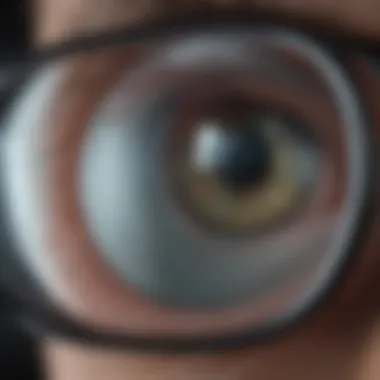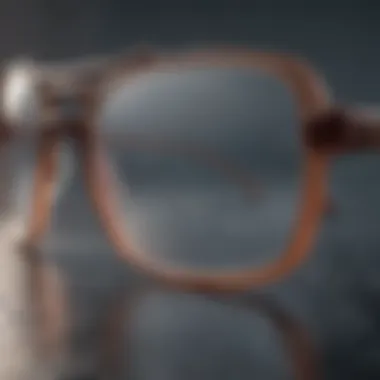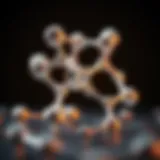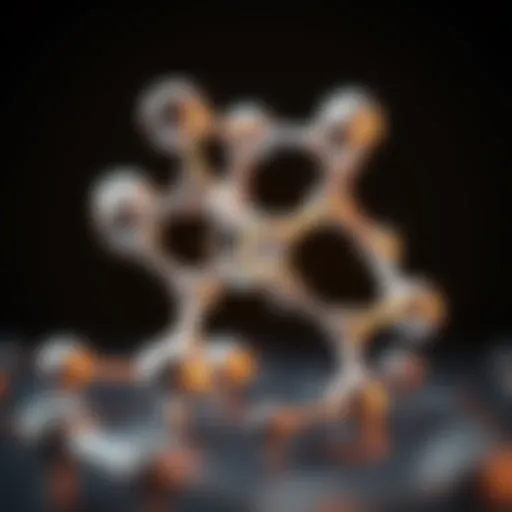Science of Anti-Fog Coatings on Glasses Explained


Intro
Anti-fog coatings on glasses have become essential in various situations. They prevent fog from forming on lenses, enhancing visibility. This is particularly critical in both everyday life and professional environments. As glasses users encounter misty conditions, understanding how these coatings work is crucial.
This article examines the composition, effectiveness, and applications of anti-fog coatings. We will delve into recent advancements in this field, alongside methodologies that have been applied in research. By exploring these aspects, readers can appreciate the significance of anti-fog technology and its practical benefits.
Recent Advances
Latest Discoveries
Recent developments in anti-fog coatings have led to more effective solutions. Researchers are now focusing on nanoparticles and hydrophilic substances. These materials enhance the durability and performance of anti-fog coatings. A noteworthy study highlighted the effectiveness of silane-based coatings. These coatings provide a stronger bond to the lens surface, increasing longevity.
Anti-fog technologies have expanded beyond traditional methods. The integration of smart coatings is emerging. These coatings adapt to different environments, maintaining clarity under varying humidity and temperature levels.
Technological Innovations
Technological innovations play a significant role in the development of anti-fog coatings. Many companies are investing in advanced research. New application techniques are being created to optimize the performance of coatings. For example, spray-on applications have shown promise. They can be easily applied by users at home, offering an accessible solution to fogging issues.
Furthermore, some manufacturers are designing anti-fog coatings that are integrated during the lens manufacturing process. This offers a longer-lasting solution that does not require user intervention. Innovations in sustainability are also at the forefront. Coatings that reduce environmental impact are gaining attention.
"Innovations in anti-fog technology not only improve visual clarity but also provide sustainable solutions for users worldwide."
Methodology
Research Design
The understanding of anti-fog coatings necessitates a structured research design. Many studies utilize a comparative approach. They analyze the effectiveness of different coating types under varying conditions. By assessing performance metrics such as clarity, durability, and resistance to fog, researchers can draw informed conclusions about their effectiveness.
Data Collection Techniques
Data collection is often multifaceted, utilizing both qualitative and quantitative techniques. Laboratory testing is common. Researchers employ standardized tests to measure fogging resistance under controlled conditions. Field tests in real-world scenarios also provide valuable insights. User feedback can highlight practical challenges and effectiveness in daily use. Surveys and focus groups can gather qualitative data on user experiences.
The findings from these methods contribute to a comprehensive understanding of anti-fog coatings, guiding future developments and innovations in this sector.
Prelims to Anti-Fog Coating
Anti-fog coatings hold significant value in various contexts, from everyday eyeglasses to specialized equipment used in demanding environments. Their effectiveness makes them sought after by individuals and professions that require clear vision despite changing environmental conditions. The ease of use and substantial benefits that these coatings provide are essential to understanding their role in enhancing visibility and safety.
In this article, we will delve into key aspects of anti-fog coatings, aiming to educate readers on how these technologies work and what they can expect in terms of performance and effectiveness. Understanding the intricacies of this subject is not merely an academic exercise; it translates into practical advantages in daily life as well.
Definition and Purpose
Anti-fog coatings are specially formulated surfaces designed to prevent the formation of fog on glass and plastic lenses. When moisture in the air condenses on the cooler surface of a lens, fog appears, obstructing visibility. The purpose of anti-fog coatings is to create a thin layer that can either repel water or spread moisture evenly across the lens. This design minimizes the creation of fog and enhances clarity when viewing the environment.
These coatings are employed widely in applications such as personal eyewear, safety goggles, and goggles used in sports. The main objective of anti-fog technology is to improve user experience by maintaining clear sight lines, irrespective of fluctuating temperatures or humidity levels.
Historical Development
The journey of anti-fog coatings dates back several decades, evolving through various technologies. Initially, many individuals relied on home remedies or simple physical adjustments to alleviate fogging in their glasses. The introduction of commercially available anti-fog coatings began to revolutionize how fogging was addressed.
Early coatings were primarily hydrophobic, intended to repel water droplets, but advancements revealed the potential of hydrophilic coatings for better fog management. Over time, innovations such as nano-coatings emerged, providing even more effective solutions.
As we continue, we will discuss the scientific principles that underline these developments and explore current trends and future directions in anti-fog technologies.
The Science Behind Fogging
Understanding the science behind fogging is crucial for comprehending how anti-fog coatings function. Fogging occurs when moisture condenses on a surface, creating a layer of tiny droplets that scatter light and obscure visibility. This process can be inconvenient, especially in contexts where clear vision is essential. By dissecting the mechanisms of fog formation, we gain insights into developing effective anti-fog solutions, thereby improving daily experiences for a wide array of users.
Mechanism of Fog Formation
Fog formation is fundamentally linked to the interaction between temperature, humidity, and the surfaces with which water vapor comes into contact. When warm, moist air meets a cooler glass surface, the temperature drop causes some moisture to condense into tiny droplets. This phenomenon can be explained through a few key principles:


- Dew point: This refers to the temperature at which air becomes saturated with moisture. When surfaces reach the dew point, moisture begins to condense.
- Surface tension: Water molecules tend to stick together, forming droplets on surfaces instead of spreading out evenly. This clustering creates the fog that obstructs visibility.
"Understanding the fundamentals of fog formation sheds light on why anti-fog coatings are necessary for everyday eyewear and safety equipment."
Addressing the fogging issue requires a nuanced approach to manipulating temperature and humidity levels around surfaces. The development of coatings becomes vital in preventing the onset of such fogging.
Role of Temperature and Humidity
Temperature and humidity are interrelated factors affecting fogging. Higher humidity increases the likelihood of condensation on cooler surfaces, leading to fog. Here's how these factors influence fogging:
- Temperature Fluctuations: When the temperature of glasses drops—like when stepping from a warm environment to a cold one—the risk of fogging increases. Maintaining a higher glass temperature can help minimize this.
- Relative Humidity: This is a measure of how much moisture is in the air compared to the maximum amount it can hold at a given temperature. As humidity increases, so does the potential for fogging. For example, a humid environment can cause fogging even at temperatures where condensation might not occur otherwise.
- Controlling Conditions: Professional settings, such as laboratories or surgical environments, often incorporate temperature control to reduce humidity. However, for everyday use, users rely heavily on anti-fog technologies.
In summary, understanding the science behind fogging gives insight into how anti-fog coatings can mitigate its effects. The coatings work by changing how water interacts with the glass surface, either by repelling the moisture or allowing it to spread uniformly, thus enhancing visibility.
Types of Anti-Fog Coatings
The type of anti-fog coating applied to glasses plays a crucial role in their effectiveness. Different coatings have unique mechanisms, advantages, and applications. Understanding these differences allows users to select the appropriate coating based on specific needs and environments. This section will explore three primary types of anti-fog coatings: hydrophilic coatings, hydrophobic coatings, and nano-coatings.
Hydrophilic Coatings
Hydrophilic coatings work on the principle of attracting water molecules. When moisture forms, instead of creating droplets, the water spreads into a thin film on the surface of the lens. This process prevents the fogging effect, allowing for clearer vision. Hydrophilic coatings are often favored for environments with significant humidity. They are typically easy to apply and can be manufactured directly into the lens during production. However, they require proper maintenance to ensure longevity.
- Benefits:
- Considerations:
- Provides consistent clarity in wet conditions.
- Generally easier to maintain and clean than other types.
- May wear out quicker when exposed to abrasion.
- The effect can diminish if not maintained properly.
Hydrophobic Coatings
In contrast, hydrophobic coatings repel water. This type of coating creates a barrier that prevents moisture accumulation on the lenses. As a result, water beads off rather than settling on the surface. Hydrophobic coatings are highly effective in environments with sudden temperature changes, such as outdoor sports. They tend to enhance visibility when transitioning between hot and cold atmospheres.
- Benefits:
- Considerations:
- Reduces the likelihood of water spots forming.
- Generally more durable compared to hydrophilic coatings.
- Can be less effective in extremely high humidity.
- Requires specific cleaning products to maintain the coating.
Nano-coatings
Nano-coatings represent the latest advancement in anti-fog technology. These coatings leverage nanoscale materials to create a protective layer on lens surfaces. Nano-coatings can be either hydrophilic or hydrophobic. They work effectively to minimize fogging by altering surface properties at a molecular level. This enables enhanced durability and longer-lasting performance. Nano-coatings are especially popular in specialized eyewear used in demanding environments.
- Benefits:
- Considerations:
- Extremely resilient against damage.
- Can be engineered for specific needs, such as scratch resistance.
- Typically more expensive to apply and produce.
- May not be as widely available as other types of coatings.
Choosing the right type of anti-fog coating is essential for optimal performance in different environments. An informed decision can make a significant difference in the user experience.
Applications of Anti-Fog Coatings
The topic of applications of anti-fog coatings is essential for understanding their real-world significance. These coatings are not merely a technological novelty; they fulfill specific needs across various fields. From everyday eyewear to safety gear used in industrial settings, the benefits are substantial. Anti-fog coatings can enhance visibility and ensure safety, making them a critical component in many environments. Each application relies on unique characteristics of the coatings, maximizing effectiveness and performance.
Eyewear
Eyewear is perhaps the most common application of anti-fog coatings. Fogging can significantly impair vision, especially during activities such as sports or driving. In everyday scenarios, spectacles worn indoors can fog when stepping outside, creating a frustrating experience. Anti-fog coatings work by reducing surface tension on the lenses, allowing condensation to spread into a thin, uniform film instead of forming droplets.
This application is particularly beneficial for individuals with active lifestyles. Skiers, cyclists, and runners rely on clear vision to navigate their environments safely. Moreover, these coatings can also improve the user experience for people who wear glasses all day, as fewer interruptions from fog can lead to an overall improvement in quality of life. Recent advances in technology, including treatments by companies like Oakley and Ray-Ban, provide options tailored for different activities and climate conditions.
Industrial and Safety Gear


In industrial settings, the application of anti-fog coatings is crucial for worker safety. Many workers wear safety glasses or goggles, and fogging can lead to reduced visibility, increasing the risk of accidents. A clear view is essential when operating machinery, conducting inspections, or working in hazardous environments. Anti-fog coatings enable operators to maintain clear vision in varying conditions—whether in a humid factory or an outdoor construction site.
Consideration for these coatings extends to personal protective equipment as well. Items like face shields can benefit from anti-fog treatments, especially when they are worn with masks. The combination of body heat and respiratory moisture often leads to fogging on protective gear.
The implementation of anti-fog coatings in industrial gear accomplishes several vital aspects:
- Improved safety: Workers maintain better visibility, reducing accident risks.
- Increased productivity: Less time spent wiping lenses means more focus on tasks.
Medical Equipment
The medical field also benefits significantly from anti-fog coatings. Healthcare professionals often wear protective eyewear, masks, or face shields while treating patients. When these items fog due to varying temperatures in the operating room or during patient examinations, it can detract from the clinical process.
Anti-fog coatings play a vital role in ensuring clear visibility for surgeons and medical staff. This clarity is crucial during delicate operations where every detail matters. In addition to surgical applications, anti-fog coatings are essential for diagnostic devices. For instance, equipment used in eye examinations can fog up easily, leading to inaccuracies in assessments.
In summary, applications of anti-fog coatings span diverse fields, each with specific needs and benefits. The consistent development of these coatings continues to address challenges in visibility, improving safety and performance in daily tasks. As advancements occur, the versatility and importance of anti-fog solutions will only deepen, solidifying their role in enhancing clarity across various environments.
Advantages of Anti-Fog Coatings
The advantages of anti-fog coatings are significant for both everyday users and professionals. These coatings enhance the clarity of vision for users, which is essential in many contexts, be it casual activities, work environments, or specialized tasks. Having a clear line of sight can tremendously impact performance and experience when fogging is minimized. Moreover, understanding the specific benefits can help users select the right devices and maintenance practices.
Enhanced Visibility
One primary advantage of anti-fog coatings is their ability to provide enhanced visibility. Fogging occurs when water vapor condenses on the glass surface due to temperature differences and humidity. When wearing glasses with anti-fog coatings, the likelihood of this condensation is reduced.
This results in:
- Clearer vision during activities: Users can engage in tasks without the distraction of fogged lenses. Whether one is in a workspace, a gym, or simply enjoying a walk outdoors in cold weather, the clarity offered by these coatings is invaluable.
- Reduced need for constant adjustments: Users may waste time wiping lenses or adjusting their glasses. Coatings eliminate this need, thus allowing for a smoother experience.
- Increased focus: When users do not have to contend with fogging, they can direct their attention to the task at hand, leading to increased efficiency in both personal and professional life.
Improved Safety
Another significant advantage is the enhanced safety provided by anti-fog coatings. Clear vision is not just a matter of comfort; it can also be a matter of safety in many situations. For instance:
- Driving conditions: For those who wear glasses while driving, fogged lenses can obstruct sight, potentially causing accidents. Anti-fog coatings help ensure that visibility remains uncompromised.
- Occupational safety: Certain professions, like construction or medical fields, require the utmost clarity for proper execution of tasks. Anti-fog coatings are crucial for safety gear such as goggles and face shields.
- Sports safety: In sports, like skiing or cycling, any obstruction of vision can lead to accidents. Coated lenses provide better control over movements when visibility is consistently clear.
"Utilizing anti-fog coatings can drastically improve both performance and safety in a variety of settings, emphasizing their utility."
Limitations and Challenges
Understanding the limitations and challenges of anti-fog coatings is crucial for users who depend on clear vision in varying environments. While these coatings provide significant benefits, they also come with certain drawbacks that could impact their effectiveness and longevity. Being aware of these issues allows consumers to make informed decisions.
Durability Issues
One of the primary concerns with anti-fog coatings is durability. Various factors can influence how long these coatings last. Environmental conditions, such as exposure to UV rays, chemicals, and physical abrasion, can degrade the coating over time.
A study on coatings indicates that hydrophilic coatings often wear off faster than hydrophobic ones. For instance, when used in high-friction environments, such as sports or industrial settings, regular cleaning can further remove or damage the coating. Users must take care to avoid harsh solvents that could degrade the layer.
"Proper handling and care can significantly extend the life of anti-fog coatings."
Effectiveness Over Time
Another significant challenge is effectiveness over time. Initially, an anti-fog coating may perform well, providing clear vision under varying humidity levels. However, its performance can diminish as the coating ages or gets exposed to contaminants like oils from skin or dust.
Regular maintenance is required to preserve the effectiveness. Users may find their glasses fogging more easily after the coating has experienced wear. Coatings can also lose their functionality if not re-applied as specified by the manufacturer. Factors that affect performance include:
- Frequency of use: The more often the glasses are worn in fog-prone situations, the quicker they may lose their effectiveness.
- Cleaning methods: Incorrect cleaning can lead to scratches or wear on the coating.
To maintain performance, consider following the manufacturer's guidelines for reapplication and cleaning. This proactive approach can prevent fogging and ensure you have clear vision when needed.
Maintenance of Anti-Fog Coatings
Maintaining anti-fog coatings on glasses is essential for ensuring their effectiveness over time. Proper maintenance not only extends the life of the coating but also guarantees optimal performance. As we have learned, anti-fog coatings rely on chemical and physical principles to function. Therefore, any improper treatment or neglect can compromise their usability. There are certain key elements to consider when discussing maintenance practices.


First, understanding how to clean the glasses properly is crucial. The surface of your glasses is delicate, and abrasive materials can easily scratch or damage the coating. Using appropriate cleaning techniques contributes significantly to the longevity of the anti-fog performance.
Second, knowing when to reapply the anti-fog coating is vital. Over time, normal wear and tear, along with environmental exposure, can diminish the effectiveness of the coating. This guideline ensures that users remain aware of their glasses’ condition and can take necessary actions in a timely manner.
Thus, proper cleaning techniques and reapplication guidelines form the backbone of effective maintenance practices for anti-fog coatings.
Proper Cleaning Techniques
To maintain anti-fog coatings, users must adopt specific cleaning procedures. Regular household glass cleaners are often too harsh for coated lenses. Here are some tips for cleaning:
- Use a microfiber cloth: This gentle material reduces the risk of scratches.
- Opt for a mild soap solution: Some users can dilute dish soap in water to create a safe cleaning solution.
- Avoid alcohol and ammonia-based cleaners: These substances can strip the coating.
Cleaning should be performed gently, avoiding vigorous rubbing, which can degrade the coating over time.
Reapplication Guidelines
Reapplying anti-fog coating is an important step that many users overlook. Several factors can indicate the need for reapplication:
- Visible fogging: If fogging occurs frequently, new application may be required.
- Duration of use: Consider reapplying if the glasses have been in service for a significant period, like several months.
- Wearing routine changes: Increased exposure to high humidity environments may necessitate more frequent reapplications.
Users may refer to specific products for guidelines on reapplication frequency and amounts. Following the manufacturer’s instructions can prevent degradation.
"Regular maintenance is the key to maximizing the benefits of anti-fog coatings, ensuring clear vision when it matters most."
Overall, understanding maintenance practices is crucial for anyone using glasses with anti-fog coatings. Routine caring ensures that coatings perform effectively, contributing to the desired clarity of vision.
Future Innovations in Anti-Fog Technology
Future innovations in anti-fog technology hold significant promise for improving visibility and performance in a variety of contexts. With the rise of advanced materials and increasing consumer demand for better vision solutions, it is essential to explore emerging trends and technologies.
These innovations can greatly enhance the functionality of anti-fog coatings. By understanding their development and potential applications, we can better appreciate their role in everyday life. There are compelling benefits to investing in these advancements. Greater durability, higher efficiency in fog prevention, and even integrated smart technologies are all on the horizon.
Emerging Materials and Techniques
Recent studies have investigated various new materials which enhance the effectiveness of anti-fog coatings. One such area of focus is the development of biomimetic materials that replicate nature's strategies to prevent fogging. For instance, scientists have looked into materials inspired by the lotus leaf, which is known for its water-repellent properties.
Researchers are also experimenting with different polymer compositions. These materials can be engineered to maintain their anti-fogging capabilities under varying environmental conditions.
Some promising techniques include:
- Layered coatings: This involves adding multiple layers of coating to achieve superior performance.
- Surface treatments: Advanced surface treatments can modify the surface properties of glasses, improving their resistance to fog formation.
- Self-cleaning coatings: These not only prevent fog but can also repel dust and grime, ensuring better visibility at all times.
Potential for Smart Coatings
The potential for smart coatings in anti-fog technology is an exciting field of research. Smart coatings can adapt to conditions in real-time. For instance, they may respond to changes in temperature and humidity, adjusting their properties to enhance visibility when fogging starts to occur.
Such improvements can affect several applications. In medical settings, for instance, smart anti-fog coatings could play a critical role in maintaining visibility for healthcare professionals who wear glasses or goggles.
Moreover, integrating smart sensors that monitor humidity levels and automatically activate additional anti-fogging properties could be a game changer in various industries.
Key considerations for the development of smart coatings include:
- Cost-effectiveness: Innovations must be affordable to encourage widespread adoption.
- Durability: Ensuring that smart features remain effective over time is crucial for user satisfaction.
- Compatibility: Coatings must work well with existing lens materials without compromising performance.
In closing, the exploration of these innovations provides a glimpse into the future of anti-fog coatings and their potential impact across various fields. It’s a fascinating area that warrants close attention.
Ending
The conclusion of this article serves as a critical reflection on the complex nature of anti-fog coatings, their technology, and their practical applications. Understanding this topic is imperative, as it not only addresses common everyday challenges related to fogged glasses but also highlights how advances in the field of material science are shaping our daily experiences.
Summary of Key Points
Anti-fog coatings fulfill a practical need for clarity in various environments. These coatings are designed to minimize condensation on surfaces, making them beneficial for eyewear, safety gear, and medical equipment. Understanding the types of coatings—hydrophilic, hydrophobic, and nano-coatings—reveals the choices available for different use cases. The effectiveness of these coatings can be influenced by multiple factors, including temperature, humidity, and the conditions under which they are maintained. Moreover, durability can pose challenges for users, as many coatings require proper care and occasional reapplication to maintain their effectiveness.
"The right anti-fog coating can dramatically improve visibility and safety in a range of situations—from snowboarding to operating rooms."
Implications for Future Use
The future of anti-fog technology holds much promise. As research progresses, emerging materials and innovative techniques may enhance the performance of these coatings. The potential for smart coatings that adapt to environmental changes might revolutionize the industry. Incorporating sensors or automated responses to fogging could provide an even more advanced solution for users. For students, researchers, and professionals, staying informed about these advancements will be crucial, as they may lead to more effective applications in various fields.















